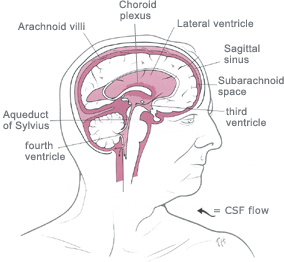| iPsychology
|
|
NPH Normal Pressure Hydrocephalus is a neurological condition which normally occurs in adults 55-years and older. NPH is an accumulation of cerebrospinal fluid (CSF) causing the ventricles of the brain to enlarge, in turn, stretching the nerve tissue of the brain causing a triad of symptoms. How is NPH different from Alzheimer's or Parkinson's? One quarter million Americans with some of the same symptoms as dementia, Alzheimer's, or Parkinson's may actually have NPH.
Hydrocephalus is an abnormal (excessive) accumulation of fluid in the head. The fluid is called cerebrospinal fluid, commonly referred to as CSF. The CSF is located and produced within cavities of the brain called ventricles. The function of CSF is to cushion the delicate brain and spinal cord tissue from injuries and maintain proper balance of nutrients around the central nervous system. Normally, the bloodstream absorbs most of the CSF produced on a daily basis. Every day your body produces a certain amount of CSF and that same amount of CSF is absorbed in the brain. When an imbalance occurs, an excess of CSF fluid builds up resulting in the condition known as hydrocephalus. Left untreated, hydrocephalus will create increased pressure in the head and may result in increased symptoms or brain damage. Symptoms of NPH Characterized by three primary symptoms, NPH patients usually exhibit:However, not all symptoms are always apparent or present at the same time. It's not just "old age" Gait disturbancesGait disturbances range in severity, from mild imbalance to the inability to stand or walk at all. For many patients, the gait is wide-based, short, slow and shuffling. People may have trouble picking up their feet, making stairs and curbs difficult and frequently resulting in falls. Gait disturbance is often the most pronounced symptom and the first to become apparent. Forgetfulness or mild dementiaMild dementia can be described as a loss of interest in daily activities, forgetfulness, difficulty dealing with routine tasks and short-term memory loss. People do not usually lose language skills, but they may deny that there are any problems. Not everyone will have an obvious mental impairment. Urinary incontinenceImpairment in bladder control is usually characterized by urinary frequency and urgency in mild cases, whereas a complete loss of bladder control (urinary incontinence) can occur in more severe cases. Urinary frequency is the need to urinate more often than usual, sometimes as often as every one to two hours. Urinary urgency is a strong, immediate sensation of the need to urinate. This urge is sometimes so strong that it cannot be held back, resulting in incontinence. In very rare cases, fecal incontinence may occur. Some patients never display signs of bladder problems. Diagnosis of NPH Diagnosis of NPH is often difficult due to the symptoms being similar to other disorders. In many cases the NPH is thought to be mild dementia, Alzheimer's, Parkinson's or simply old age factors. Many cases go completely unrecognized and are never treated. Usually, NPH causes the ventricles to enlarge due to increased CSF within the skull. If a person exhibits symptoms of hydrocephalus a physician may perform several tests to determine if shunting is an option. The most common diagnostic tools are neuro-imaging devices such as CT or MRI and a careful clinical assessment. Once the diagnosis of NPH is suspected there is no single perfect test to determine if a patient will respond to the shunt. At this point in the diagnostic process, it is important that a neurologist and a neurosurgeon become part of your medical team, along with your primary care physician. Their involvement from the diagnostic stage onward is helpful not only in interpreting test results and selecting likely candidates for shunting, but also in discussing the actually surgery and follow-up care as well as expectations of surgery. The decision to order a given test may depend on the specific clinical situation, as well as the preference and experience of your medical team. Diagnostic procedures Diagnostic procedures for normal pressure hydrocephalus may include one or more of these tests: ultrasound, computerized tomography (CT), magnetic resonance imaging (MRI), lumbar puncture or tap, continuous lumbar CSF drainage, intracranial pressure (ICP) monitoring, measurement of cerebrospinal fluid outflow resistance or isotopic cisternography, and neuropsychological testing. CT Scan (Computerized Tomography): creates a picture of the brain by using x-rays and a special scanner. It is safe, reliable, painless, and relatively quick (about 15 minutes). An x-ray beam passes through the head, allowing a computer to make a picture of the brain. A CT will show if the ventricles are enlarged or if there is obvious blockage. MRI: is safe and painless, and will take approximately 30 minutes or longer. MRI uses radio signals and a very powerful magnet to create a picture of the brain. It will be possible to detect if the ventricles are enlarged as well as evaluate the CSF flow and provide information about the surrounding brain tissues. The MRI provides more information than the CT, and is therefore the test of choice in most cases. MRI scans can also assess how fast CSF moves through a particular part of the brain called the cerebral aqueduct. Patients with cardiac pacemakers or certain other metallic implants cannot have MRI scans because of potential interference with the pacemaker. Lumbar Puncture or spinal tap: This allows an estimation of CSF pressure and analysis of the fluid. Under local anesthetic, a thin needle is passed into the spinal fluid space of the low back. Removal of up to 50 cc of CSF is done to see if symptoms are temporarily relieved. If removal of some CSF dramatically improves symptoms, even temporarily, then surgical treatment may be successful. All physicians do not advocate the use of a lumbar puncture as a screening test for NPH since many people who experience little or no improvement after the test may still improve with a shunt. Lumbar catheter insertion: This is a variation of the lumbar puncture. A spinal needle is inserted in the spinal fluid space of the low back, then a thin, flexible tube (catheter) is passed into the spinal fluid and the needle is removed. The lumbar catheter allows for continuous and more accurate recording of spinal fluid pressure, or for more continuous removal of spinal fluid over several days to imitate the effect that a shunt would have. Patients who respond dramatically to such spinal fluid drainage are likely to respond to shunt surgery. Intracranial pressure monitoring: ICP monitoring requires admission to the hospital. A small pressure monitor is inserted through the skull into the brain or ventricles to measure the ICP. The pressure is not always high, and pressure monitoring (either by lumbar catheter or the intracranial method) can detect an abnormal pattern of pressure waves. Measuring CSF outflow resistance: This is a more involved test that requires a specialized hospital setting. In essence, this test assesses the degree of blockage to CSF absorption back into the bloodstream. It requires the simultaneous infusion of artificial spinal fluid and measurement of CSF pressure. If the calculated resistance value is abnormally high, then there is a very good chance that the patient will improve with shunt surgery.Isotopic cisternography: This procedure involves having a radioactive isotope injected into the lumbar subarachnoid space (lower back) through a spinal tap. This allows the absorption of CSF to be evaluated over a period of time (up to 96 hours) by periodic scanning. This will determine whether the isotope is being absorbed over the surface of the brain or remains trapped inside the ventricles. Isotopic cisternography involves spinal puncture and is considerably more involved than either the CT or MRI. This test has become less popular because a "positive" cisternogram result does not reliably predict whether a patient will respond to shunt surgery. Neuropsychological Test: This testing involves asking a series of questions used to determine if there is a loss of brain function due to hydrocephalus. Treating NPH The treatment of choice for NPH patients who show a positive response to diagnostic testing is the placement of a CSF shunt. A shunt is an implantable device designed to drain CSF fluid away from the brain thereby allowing the enlarged ventricles to return to a normal state. As CSF fluid builds and the pressure in the ventricle increases, a one-way shunt in the shunt opens, and the excess CSF fluid drains into the abdomen where it is easily absorbed. This technique is very effective in improving the troubling symptoms of NPH. With a traditional fixed pressure shunt, choice of the correct pressure setting is very important as under-drainage will not improve symptoms, whereas over-drainage can cause symptoms in itself, or predispose to problems such as subdural hematoma. Incorrect choice of a fixed pressure shunt requires removal of the original shunt, and repositioning of a different one. Surgical revisions such as this can be avoided if your neurosurgeon is certified in the use of programmable shunt technology. With a programmable shunt, the pressure setting can be adjusted with a special magnetic programmer in your doctor's office, eliminating the need for additional surgery if the initial setting proves not to help. |

